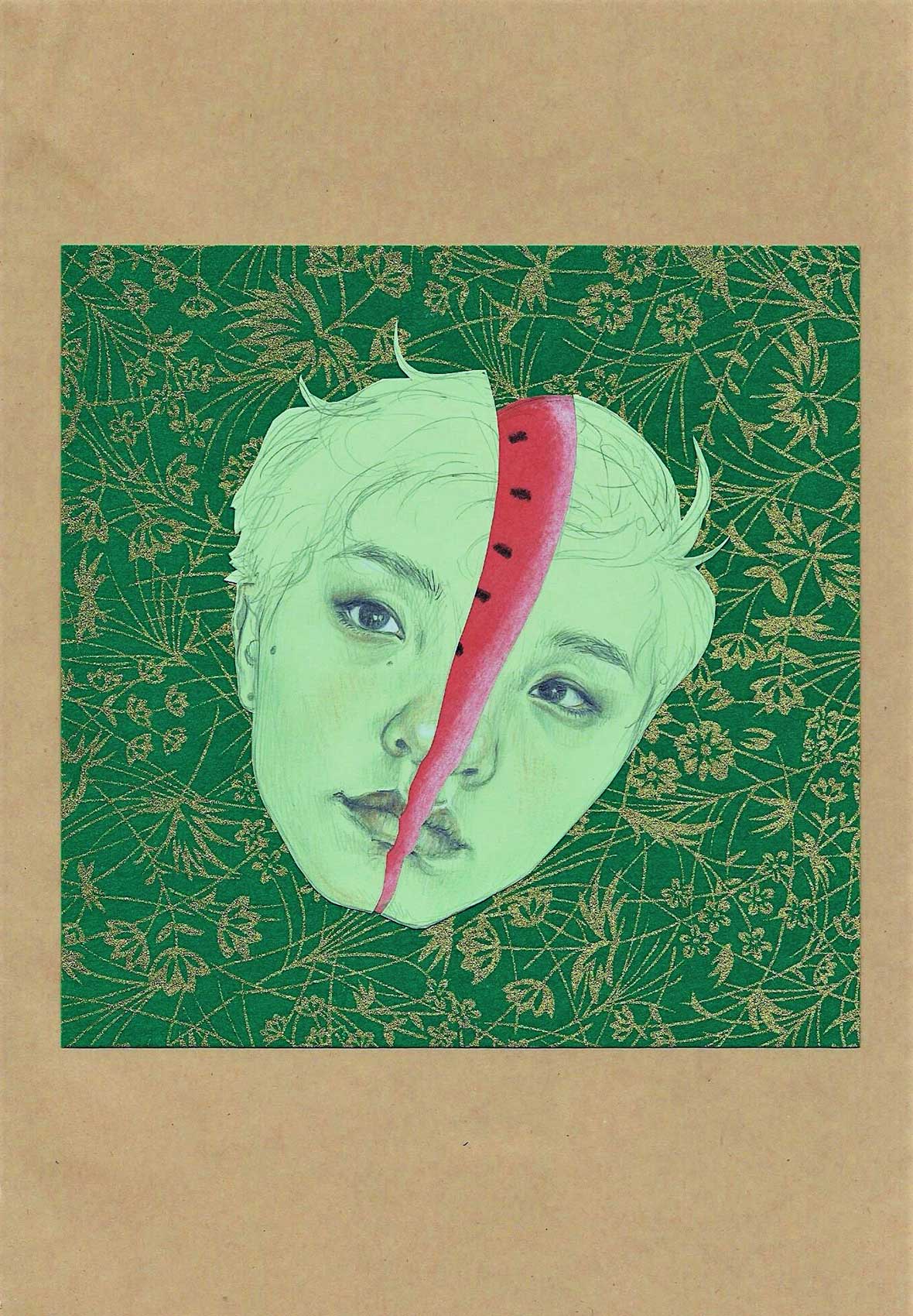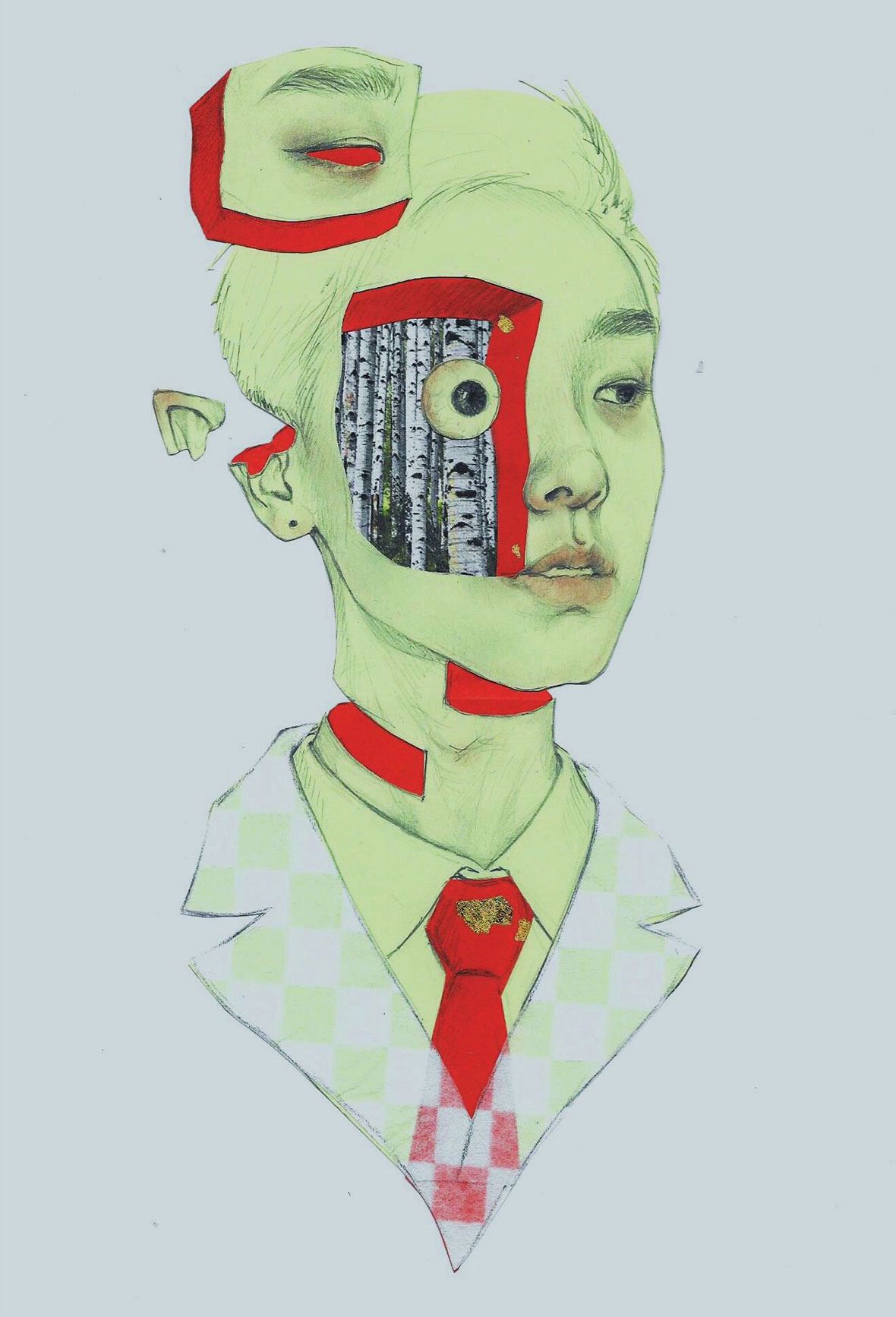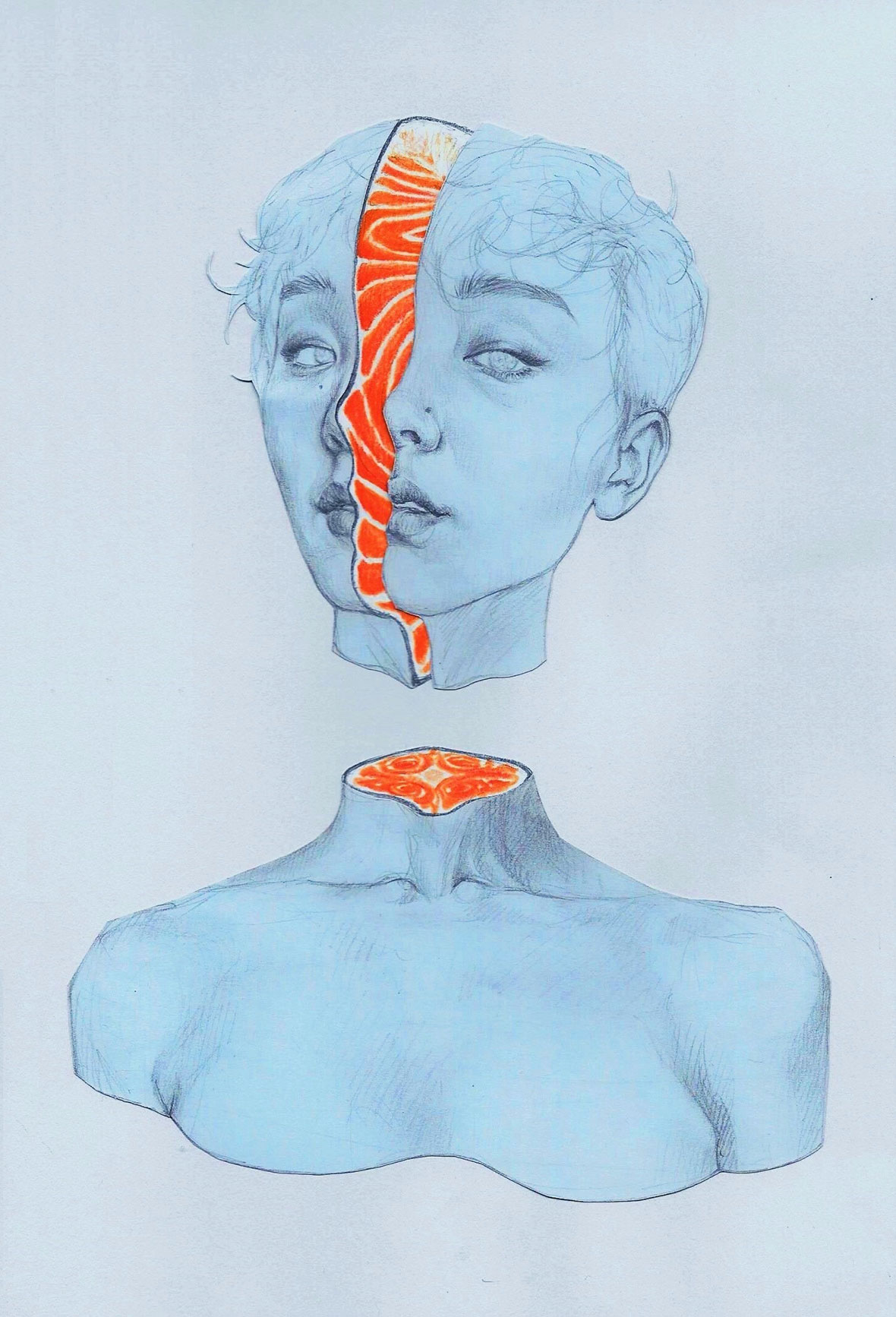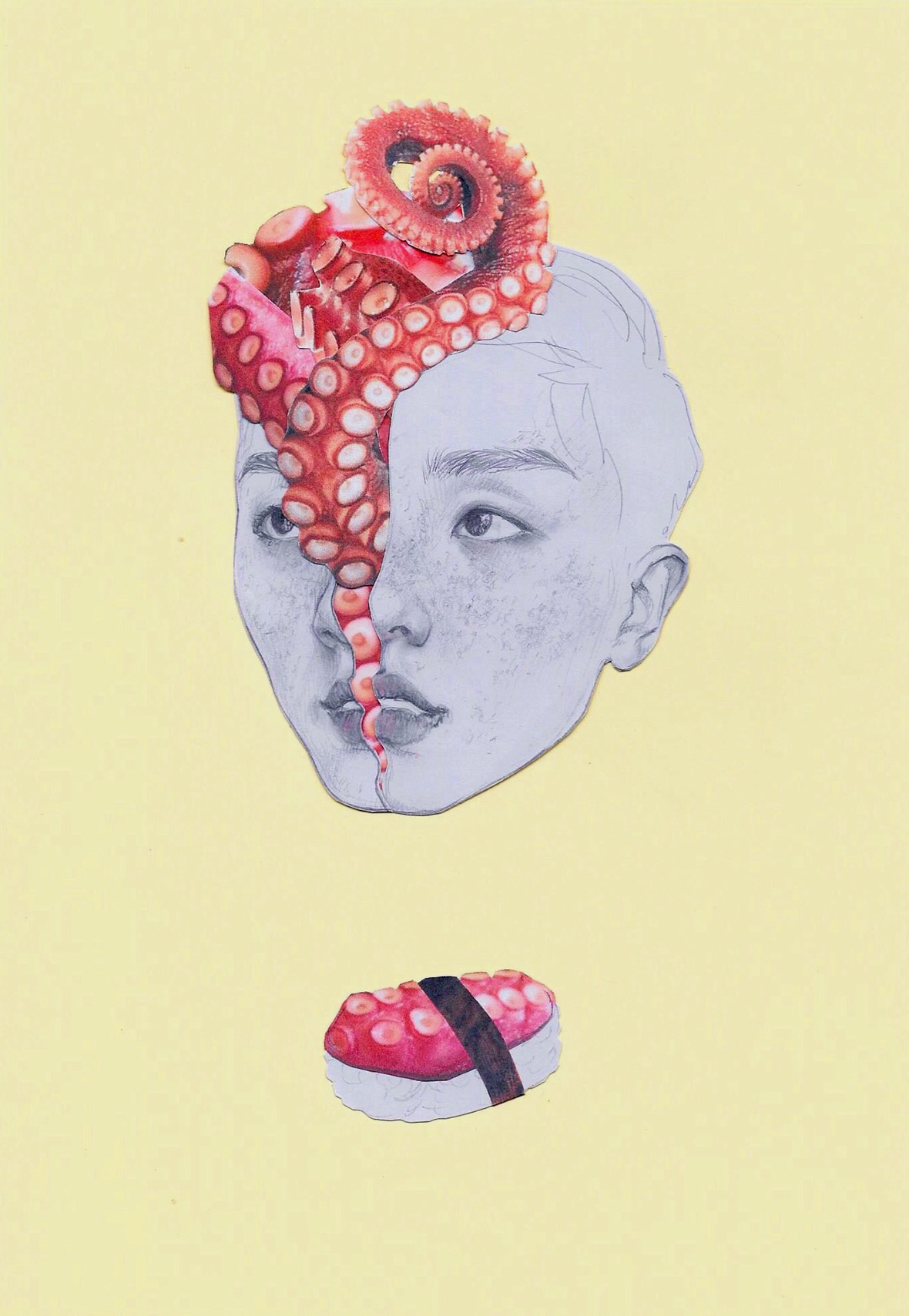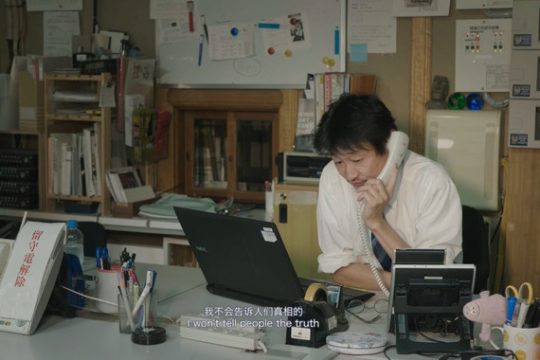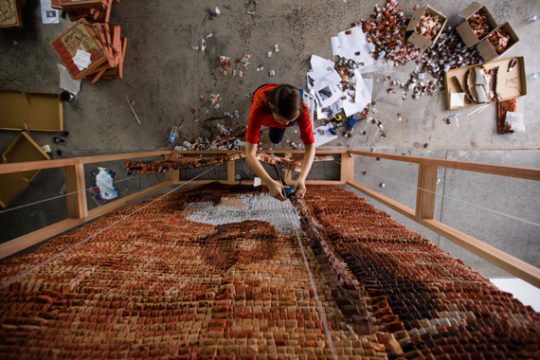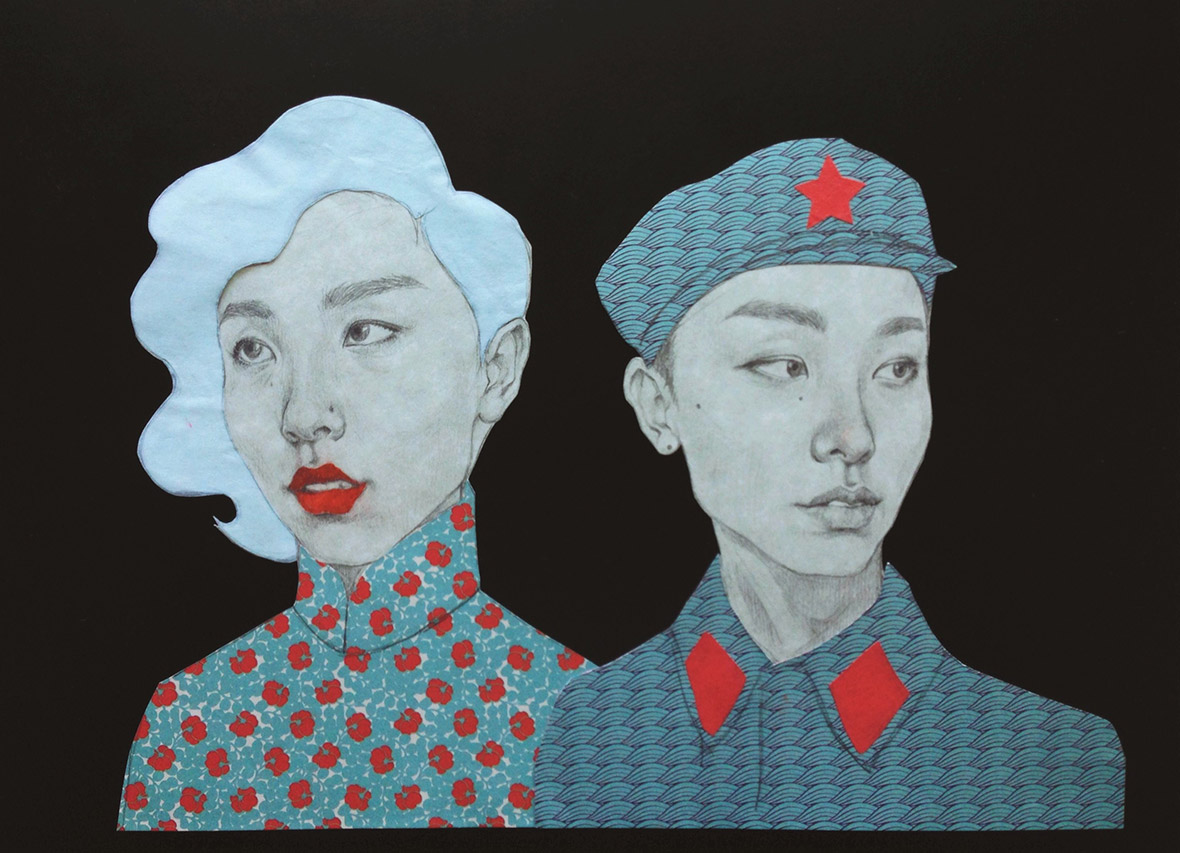
Yuqing Zhu is a Chinese American artist, writer, and Ph.D. student in neuroscience at the University of Chicago. Using materials including pencil, chiyogami paper, origami paper, and magazine cut-outs, Zhu creates colorful self-portraits that examine the nature of identity and culture. Neocha spoke with Zhu to learn more about her life, art, and studies. Check out the conversation below.
朱禹清(Yuqing Zhu)是一名美籍华裔艺术家和作家,目前在芝加哥大学攻读神经学博士学位。通过铅笔、千代纸(Chiyogami)、折纸、杂志上剪下的图片等材料,她创作了一系列彩色自画像,以此对自我身份和文化本质进行审视。Neocha和朱禹清聊了一下,进一步去了解她的生活、艺术和学业。一起来看下这段对话吧。
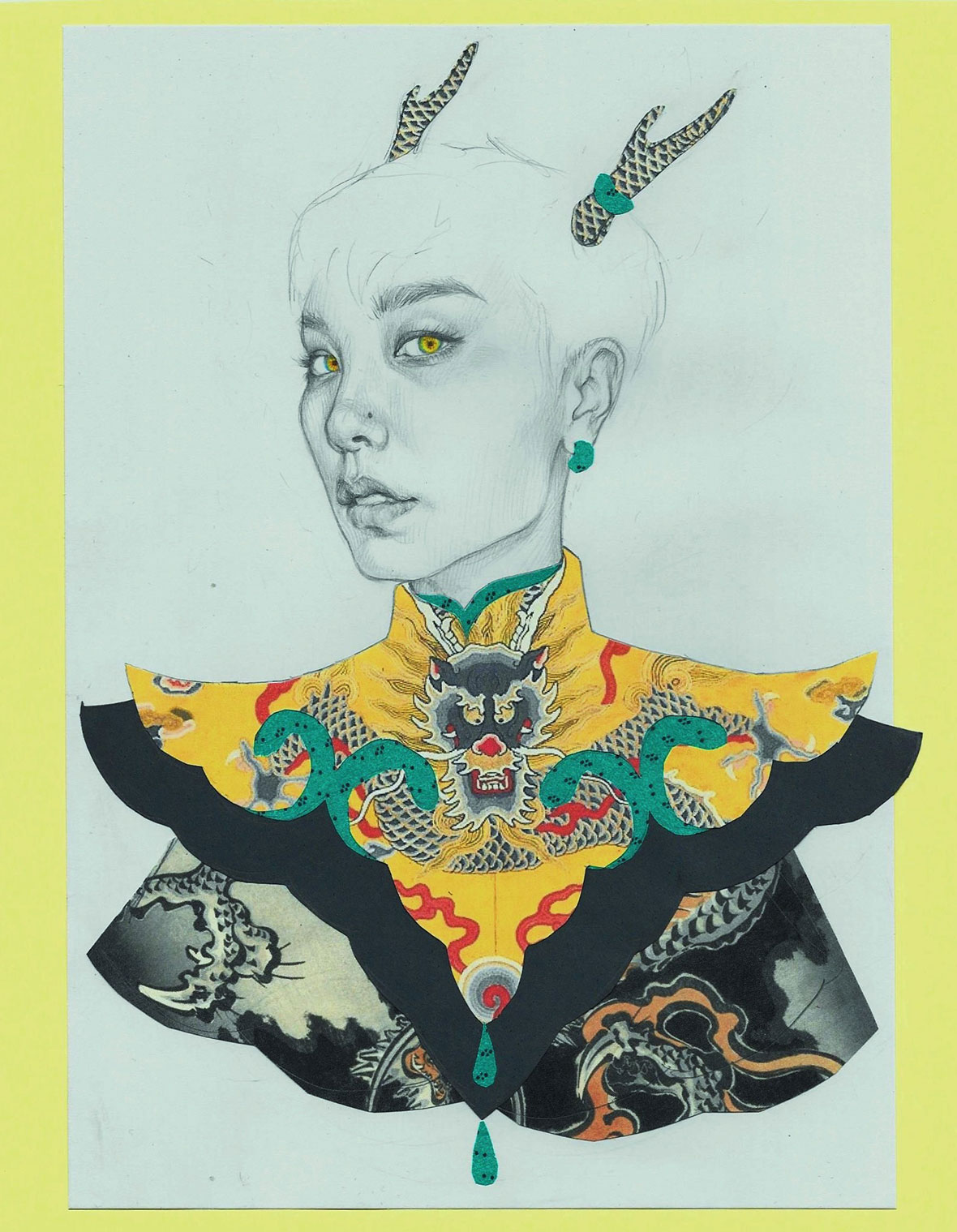
Neocha: As a neuroscience student, how do you balance your art with your academic studies?
Zhu: Before beginning my program, someone told me that finding a hobby as soon as possible is the best way to keep sane. Luckily for me, I already had something. I think the key to finding balance was by assigning equal importance to both art and science. It’s truly a matter of mindset. I’m serious enough about neuroscience to be part of a five-year-plus Ph.D. program, so it’s quite a struggle to match that level of dedication in my art! I may need to spend more time in lab or in lecture, simply due to the nature of the work, but I try to think about and create art consistently as well.
Some days I recognize that I’ve been neglecting creating art for too long. On those days I simply put down my science and draw. This usually rejuvenates my work on the science side as well. Scientific research can devolve into a lot of drudgery and grunt work but doing something creative reminds me to think broadly and reassess where I’m at. My most inspired periods in the lab usually match up with my most productive periods at the easel.
Neocha: 作为一名神经科学的学生,你如何平衡自己的艺术创作与学业?
Zhu: 在我开始修读学位之前,有人劝我尽快找个爱好,这是让自己保持理智的最佳方式。幸运的是,我早就有这样的爱好。我觉得,找到平衡的关键是对艺术和科学赋予同等的重要性。这确实就是心态的问题。我对于学神经科学是很认真的,所以才会决心读一个5年多的博士学位课程,所以要在艺术方面也投入同等的专注,确实不容易。我可能会花更多的时间在实验室或上课,主要是因为这个专业本身的需要,但我会尽量保持不断地去思考和创造艺术。
有些时候当我发现自己太长时间没有进行艺术创作时,我会先把学习放在一边,去画画。这样一来,我在科学学习时也会有更多新的能量。科学研究常常需要做很多苦差事和繁重的体力劳动,所以进行一些创意创作可以提醒自己想得更广,重新评估自己的位置。我在实验室受启发最多的时候,往往也是我艺术创作最多产的时期。
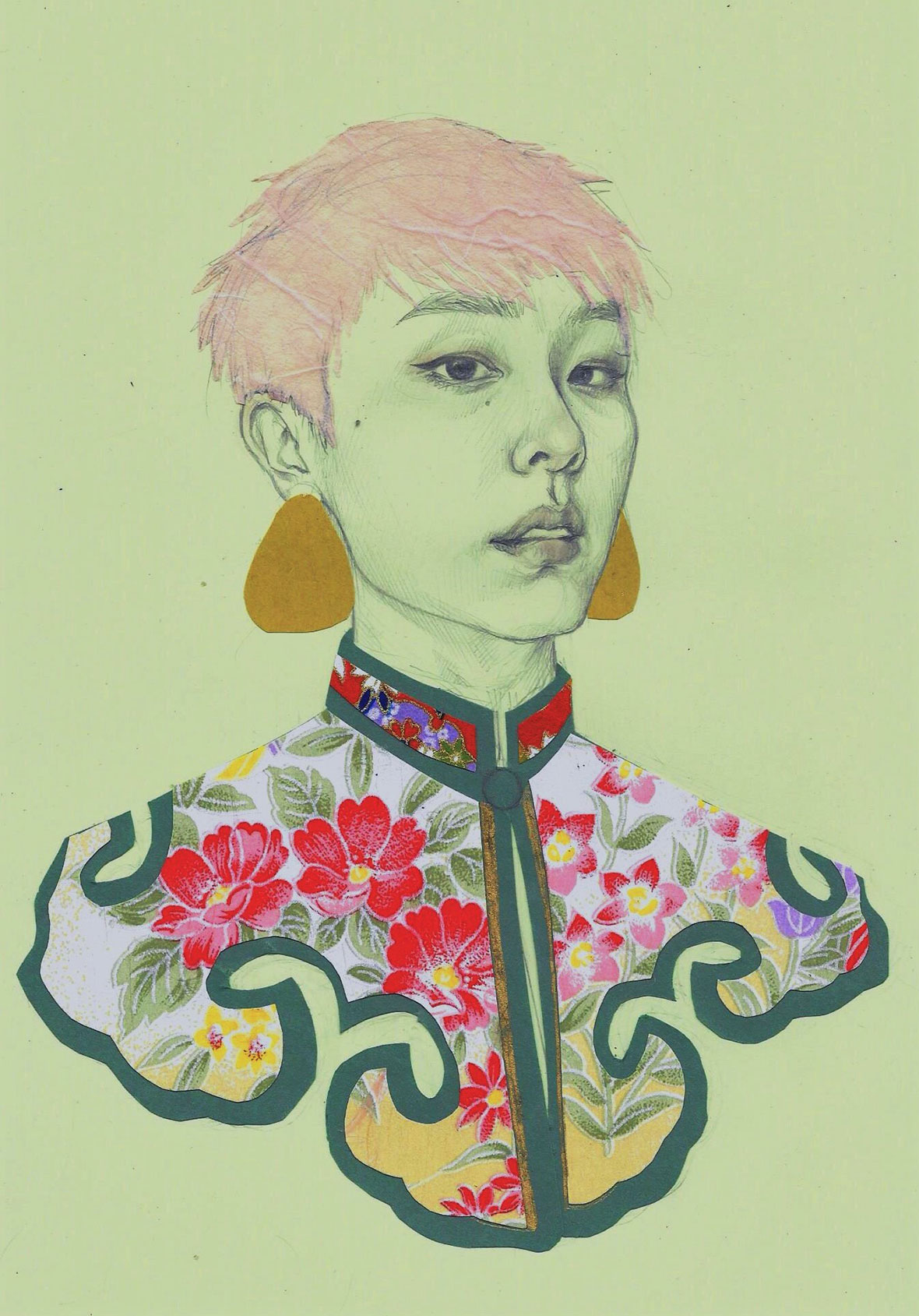
Neocha: What are some of the parallels between art and neuroscience?
Zhu: I’ve had a lot of people ask me this question, and I’m not sure if I can give a satisfactory answer even to myself! Here’s my shot at it: art and science are both parts of an abstract search for the balance between beauty and complexity. Self-portraiture and neuroscience are both parts of an abstract search of the core of one’s identity beyond one’s own biases.
I adore complexity. It wasn’t always obvious that the complex system I wanted to study was the brain. I used to, and still do actually, love things like M. C. Escher’s prints and delight in the extremely dense inkwork of Edward Gorey and more recently of Manabu Ikeda. Complex interactions in anything from ecology to musical scores are still fascinating to me.
A lot of times neurobiology gives you extremely elegant solutions to complex problems. How do we hear? How do entire nervous systems develop from embryonic stages into adulthood? How can we sense things like temperature, and how do we perceive things like colors? When systems like these come to be understood and explained, we realize how logically elegant they are! That doesn’t mean the solutions are simple or straightforward or even the most efficient, but nonetheless, they work, and I find them beautiful! A large part of the time we don’t know the full answer yet. For me, the process for finishing a work of art is the same as for finding a piece of evidence in the framework of a scientific theory.
Neocha: 艺术与神经科学之间有什么相似之处?
Zhu: 已经有很多人问过我这个问题,即使是回答自己,我也不确定可不可以给出一个满意的答复!不过我可以试一下。艺术和科学都属于为寻找美丽和复杂性之间的平衡而作出的一种抽象性探索。自画像与神经科学都属于为寻找一种超越自己偏见、核心的自我身份认知而作出的一种抽象性探索。
我崇拜复杂性。以前我没搞清楚原来自己一直想研究的复杂系统就是大脑。我以前(现在也仍然)很喜欢M. C. Escher的版画,Edward Gorey以及最近很喜欢的池田学(Manabu Ikeda)他们那些极其细腻的钢笔画。从生态学到乐谱,任何事物间复杂的相互作用对我来说都充满魅力。
很多时候,神经生物学可以给你一个极其优雅的答案,来回答复杂的问题。我们是怎么听声音的?整个中枢神经系统如何从胚胎阶段发展到成年期?我们如何能感觉到温度,或者我们如何感知色彩?当我们能够理解和解释这些系统时,我们会意识到,它们有着多么优雅的逻辑!这并不意味着它们所提供的答案是简单的、直接的,也不是最有效率的,但它们是行得通的,而且我觉得很有美感!大部分的时间,我们还未知道全部的答案。对我来说,完成一件艺术品的过程与在某个科学理论的框架里又找到一块证据是一样的。
Neocha: Expanding on that, are there any other similarities between the creative process for art versus science?
Zhu: I think the creative process is crucial for good science. You can’t create good art or do good science by being dogmatic about it. Scientific research is all about finding something new that’s never been known before. Art is about creating something that has not existed in the world before. Paradigm shifts occur in science as well as in art! New movements emerge when individuals dare to look at things in vastly different ways. The move from geocentrism to heliocentrism, from Lamarckian inheritance to Darwinian evolution (and now to a complex epigenetics that is beyond me), all happened because scientists dared to think differently!
Neocha: 进一步说,科学与艺术创作的过程之间有其它的相似之处吗?
Zhu: 艺术创作的过程对于进行科学研究也是关键。如果太过于教条主义,你不能创作出好的艺术,也不能进行很好的科学研究。科学研究就是要寻找人们未知的新事物。而艺术是要创造出世界上之前并不存在的事物。范式转变在科学和艺术上都会发生!当个体敢以截然不同的方式看待事情时,就会催生新的运动出现。从地心说到日心说的转变,从拉马克获得性遗传到达尔文的进化论(再到现在超越我理解的复杂的表观遗传学)的发展,都是因为有科学家敢于从不同角色思考而发生的!
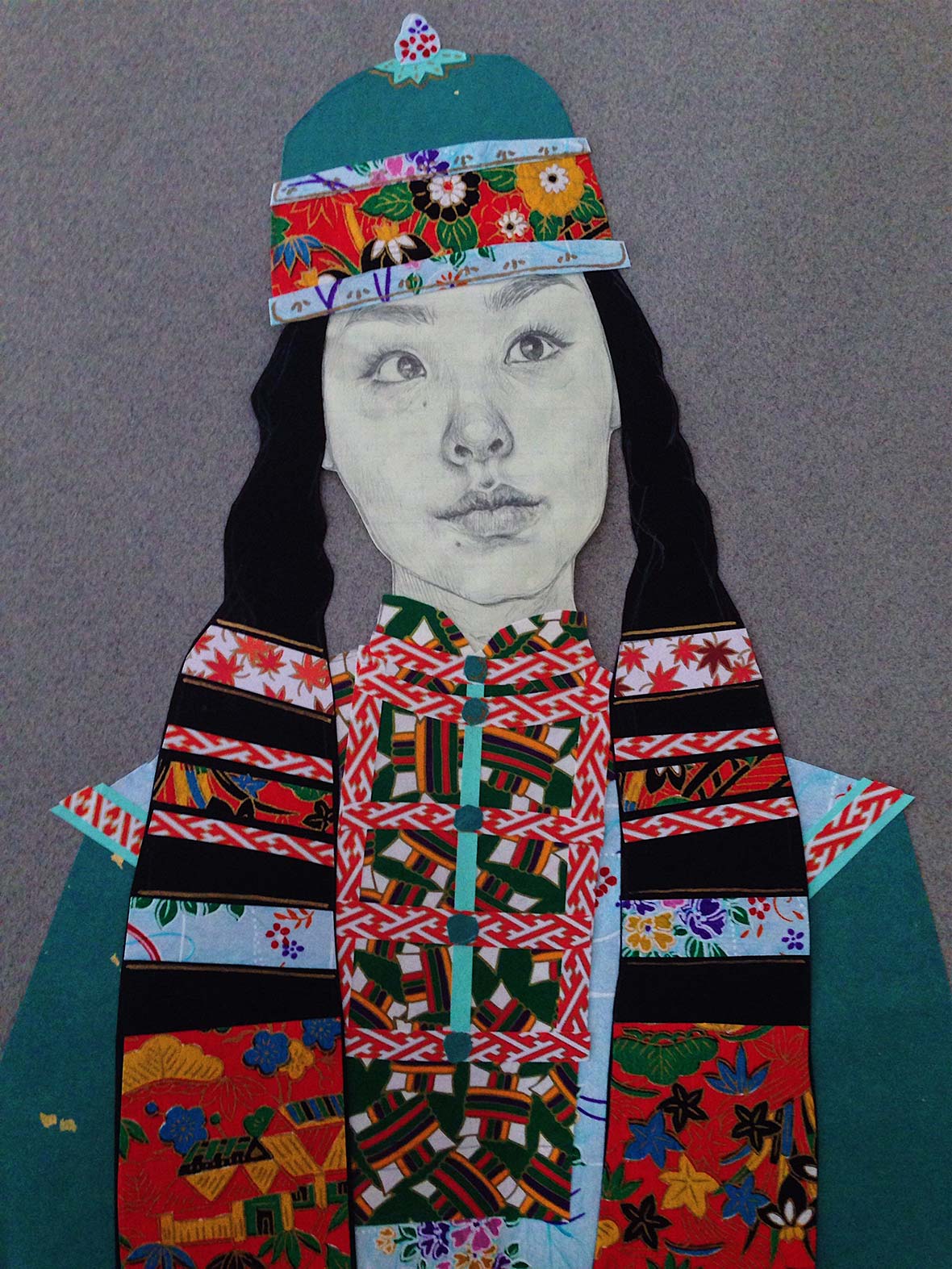
Neocha: What does your personal creative process usually look like?
Zhu: The process of creating a portrait is very straightforward. I can pull up a piece of paper and simply start drawing. Sometimes I’ll draw myself without much thought. Those are usually sketches to be filed away. Other times a specific idea will come to mind, and I’ll act on it. I like to finish pieces in one long breath – I’ll think of something as I eat breakfast and by the time I go to sleep that night it’ll be finished. Of course, I usually don’t spend that whole stretch of time literally drawing. Almost every portrait involves a little bit of research about the historical period I’m assuming in my clothing or looser web browsing for inspiration and references.
I’m terrible about finishing something that I started on a different day. I guess it’s possibly because when I wake up the next morning I feel like a brand new self and the half-finished piece no longer has power as a part of me. I rarely sit and ponder or actively brainstorm for a portrait. The pieces fall together as I work.
Neocha:你艺术创作的过程一般是怎样的?
Zhu:创作画像的过程很简单。拿出一张纸,我就开始画画。有时我会画自己,也不会想太多。那些一般只是一些蓝图,很快就放在一边去了。其它时候,如果突然想到一个特定的想法,我就会将这个想法画下来。我喜欢一口气完成几幅画,可能我吃早餐的时候有了一些想法,然后到我那天晚上去睡觉前就可能已经创作出来。当然,我不会真的一整天一直画个不停。在画每一张画像前,我几乎都会先对画像中预想的服装造型所涉及到的年代进行一点研究,或是随意地上网浏览,来找灵感和参考。
我很怕要去画完我前一天开始的作品!可能是因为,当我第二天醒来的时候,会感觉自己已经是一个全新的自我,之前创作了一半的画已经不再是我的一部分,也失去了它原本的力量。我很少会特意坐下来去思考,或进行头脑风暴,来想如何创作一幅肖像画。通常我一边工作的时候就一边想好了应该怎样进行创作。
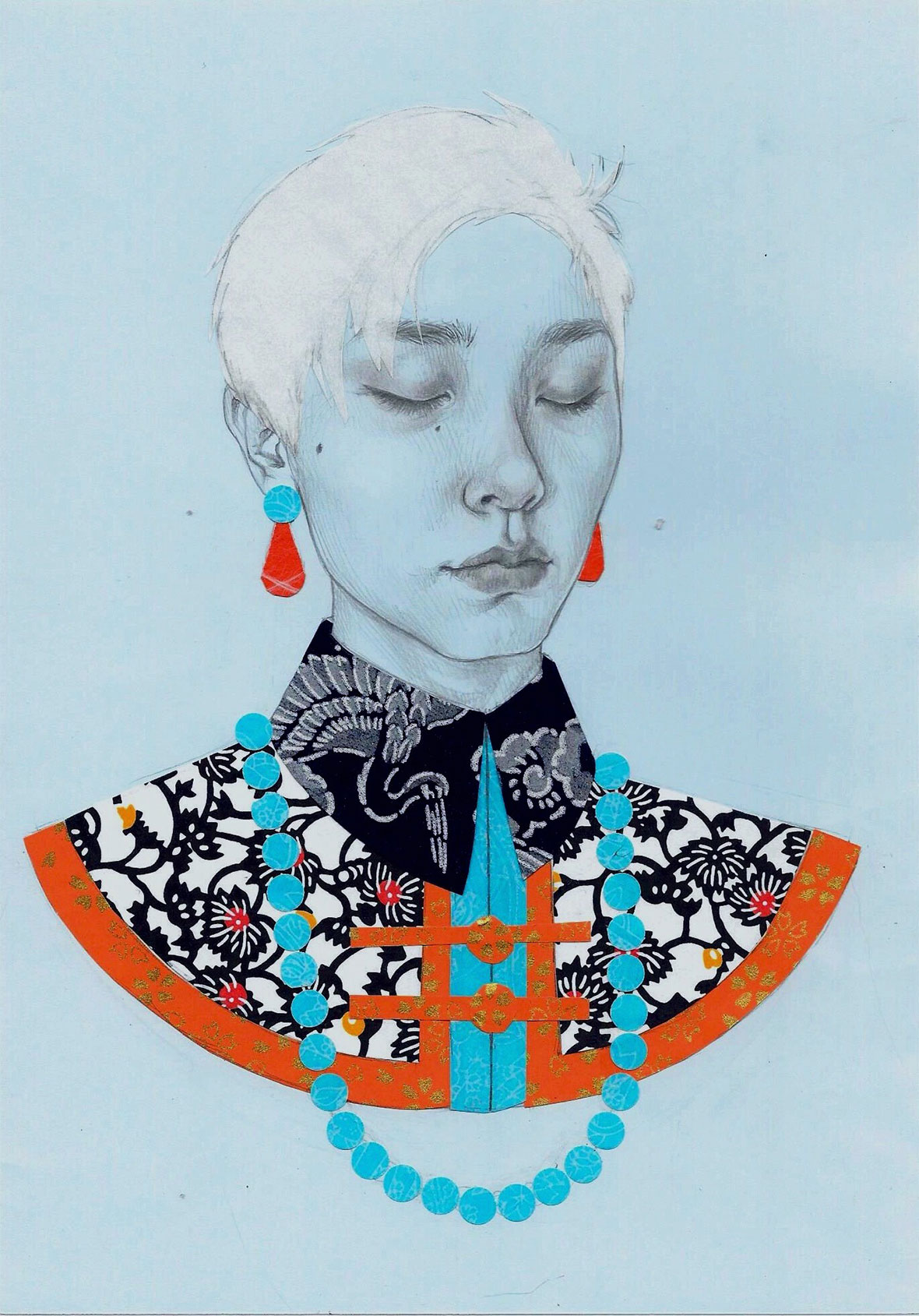
Neocha: How does heritage influence your work?
Zhu: I try to learn as much as I can about something before I incorporate it as a facet of my portraits. This is especially important for Chinese history – if I don’t understand something sufficiently (it’s the science researcher’s mindset), I feel like a fraud, like I’m wearing a “Chinese Halloween costume.” Sometimes I feel very far removed from China and its peoples and their rich history. Creating these self-portraits is a way to look at myself and see who I may be inside or the ancestors I contain.
The color palettes that I use are definitely inspired by the colors of modern metropolitan China as well as the dynastic past. Sometimes I have misgivings about using chiyogami. I try to pick patterns that are in common with traditional Chinese textiles and not ones that are uniquely Japanese since that culture is not part of my heritage. I got the idea of dressing my self-portraits from my paternal grandmother. She used to cut out patterned paper to decorate or altogether recreate scenes from children’s books, creating beautiful, intricate collages. Right now, I use a similar technique to what she did with tracing paper. I draw myself, get a rough sense of which collage elements I will need to overlay, and then use tracing paper in order to get the outlines exactly right. Then I use that as a stencil to cut shapes out of patterned paper.
Neocha: 你自身的文化背景如何影响你的作品?
Zhu: 在我将某种元素融入我的肖像画时,我都会先尽可能多地去了解它。尤其是关于中国的历史,如果我不能充分地了解某种事物(这是一种科学研究者的心态),我会感觉自己像个骗子,仿佛我披了一件“中国的万圣节服装”。有时,我会觉得自己与中国、中国人和他们丰富的历史隔得非常遥远。而创作这些自画像就变成一种审视自己的方式,让我去了解自己的内心,了解我所来自的文化。
我的色彩灵感来自现代中国的大都市和过去的王朝历史。有时,对于使用千代纸我也会有一些顾虑。我会尽量选用一些图案更贴近中国传统纺织品,而不是那些一看就是日本风格的千代纸,因为日本文化不属于我的文化背景。我后来想到了按照奶奶的打扮来画自画像。她以前常常用来剪出的图案纸装饰或重新设计儿童书籍中的场景,打造出错综复杂的美丽拼贴画。现在,我按照她的手法,在描图纸上创作。我通常先画出自画像,大概感觉下我可能需要怎样的拼贴元素,然后使用描图纸,获得正确的轮廓。然后用它作为模具,从图案纸上剪出形状。
Neocha: How have art and science changed your perception of self and identity?
Zhu: We are so, so biased in our conception of our brains because our thoughts can never escape them. Oftentimes, we fall into the trap of “this is so obvious,” when actually our firsthand experience is quite wrong. For example, our visual perception of the world is just a useful approximation of what is truly there. The perception of color – a biological representation of the electromagnetic spectrum across animal species – is the most fascinating thing to me (not to mention the phenomenon of consciousness, a taboo topic for most neuroscientists still). Working past, and sometimes outright rejecting the ideas that we hold based on our own brainy experiences is central to the practice of good neuroscience.
Self-portraiture is the exact same. We as individuals don’t, in fact, have an accurate idea of what we look like, much less of who we truly are. Someone once told me that, while I was pretty accurate at drawing other people, my own portraits were lacking. This was perhaps a year ago. That’s the point at which I began to draw myself in earnest and to strive for self-understanding and representational accuracy. I try to portray different aspects of what I understand as my actual self in my self-portraits. More and more, these are buried aspects – split open my face and what would you find? An octopus – an organism that is remarkably intelligent yet with an altogether alien nervous system. Do they operate at similar levels of cognition as humans? What would that mean in practice? Put my past in front of me, dress me in Qing Dynasty robes, and what do we have? The truth or still a self-distortion? As a young Chinese American, when I assume the attire of Communist-era China, am I connecting to my parents’ generation, or am I romanticizing a past that I do not have any true ownership of? These are questions I can’t yet answer.
Neocha: 艺术和科学如何改变你对自我和身份的看法?
Zhu: 我们大脑里的观念充满了偏见,因为我们的思想离不开大脑。很多时候我们掉进一些所谓“显而易见”的陷阱,但实际上,我们的亲身经验却是错的。例如,我们对世界的视觉感知只不过是真实世界的近似值。对色彩的感知——电磁频谱在动物物种间的生物表述——是对我来说最有趣的事情(更不用提“意识”这个在大多数神经科学家中仍然是禁忌话题的现象)。要进行有效的神经科学实践,我们要抛开,甚至直接否定这种我们根据自己自以为是的经验所得出的想法。
自画像也一样。作为个人,我们事实上并知道自己真实的样子,更不知道我们到底是谁。有人曾告诉我,虽然我画其他人的时候画得很像,但画自己就不是那么准确了。那大概是一年前的事情了。但从那时起,我才开始认真画自己,努力去理解自己,准确地描绘出自己。我试着从不同侧面,在我的自画像中描绘出我所理解的真正自我。慢慢地,我的笔下出现了越来越多那些曾被掩埋的一面,撕开我的脸,你会找到什么?章鱼是一种非常聪明的有机体,却有着人类完全陌生的中枢神经系统。它们的认知水平是不是跟人类类似?在实践中,这将意味着什么?将我的过去放在我的面前,让我穿上清朝的长袍,又会产生什么呢?是真相,还是依然只是扭曲的自我?作为一名年轻的美籍华人,当我穿上共产主义时代的中国装束时,我是让自己回到了我父母那个年代,还是在美化这种我并未真正拥有过的过去?这些都是我还无法回答的问题。
